Argument Paper: Employee Satisfaction, Emotions, and Leadership
VerifiedAdded on 2022/08/25
|6
|1082
|19
Essay
AI Summary
This argument paper examines the critical role of employee satisfaction within organizations, emphasizing the need to understand and address the emotional needs of the workforce. The paper highlights the importance of employee satisfaction for smooth operations and problem-solving, while acknowledging the complexities of managing employee emotions. A literature review explores the impact of emotions on workplace culture, referencing studies that connect employee emotions with cultural needs, communication, and potential challenges. The paper discusses the balance between positive and negative emotions, employee motivation, and the role of leadership in fostering a positive work environment. The author argues that organizations must value employees' emotional needs to enhance their motivation and contribute to the company's success, while also considering the potential challenges that can arise from individual differences in emotional responses. The paper concludes that a distinct balance of emotions is needed for the growth of both the employees as well as the organization.
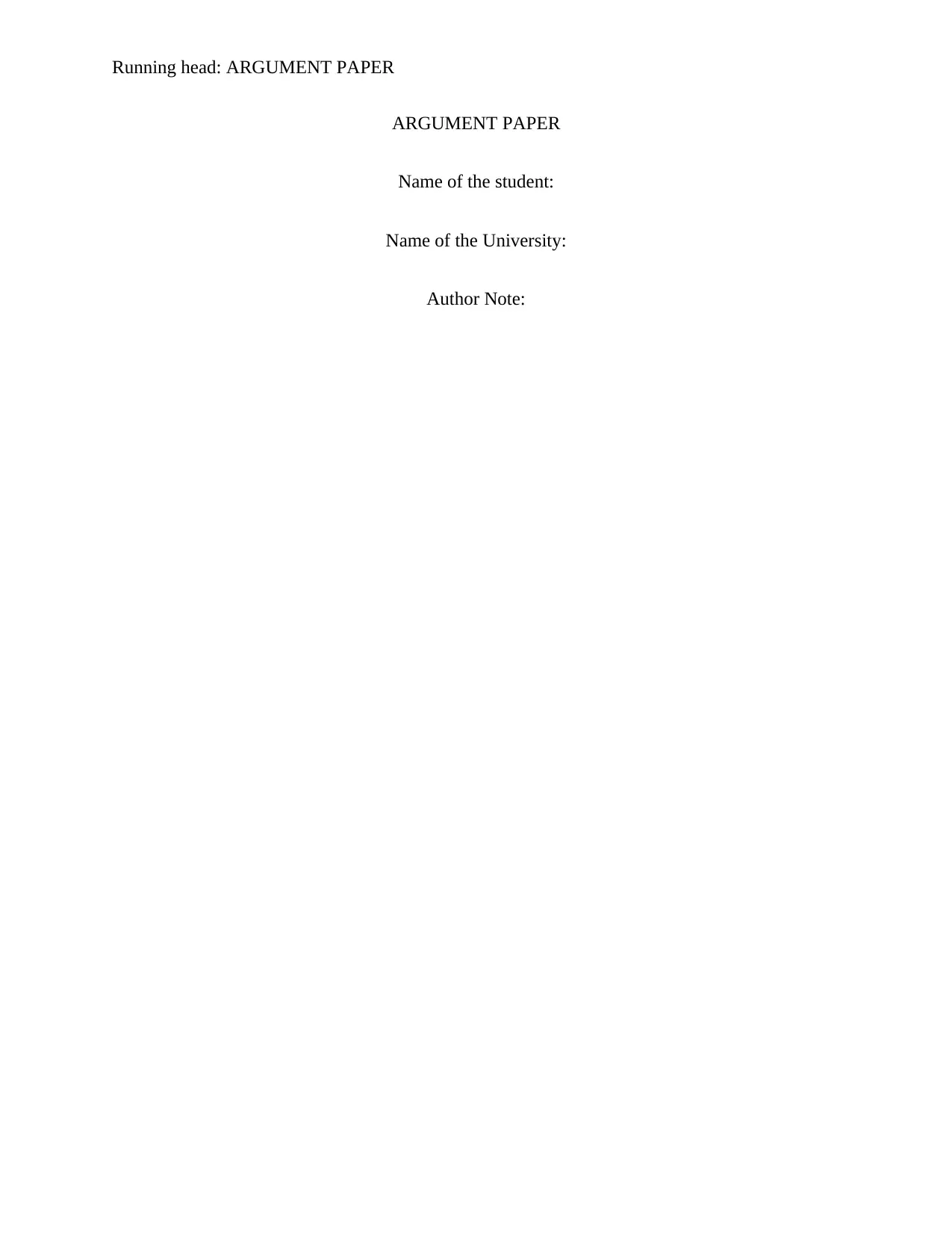
Running head: ARGUMENT PAPER
ARGUMENT PAPER
Name of the student:
Name of the University:
Author Note:
ARGUMENT PAPER
Name of the student:
Name of the University:
Author Note:
Paraphrase This Document
Need a fresh take? Get an instant paraphrase of this document with our AI Paraphraser
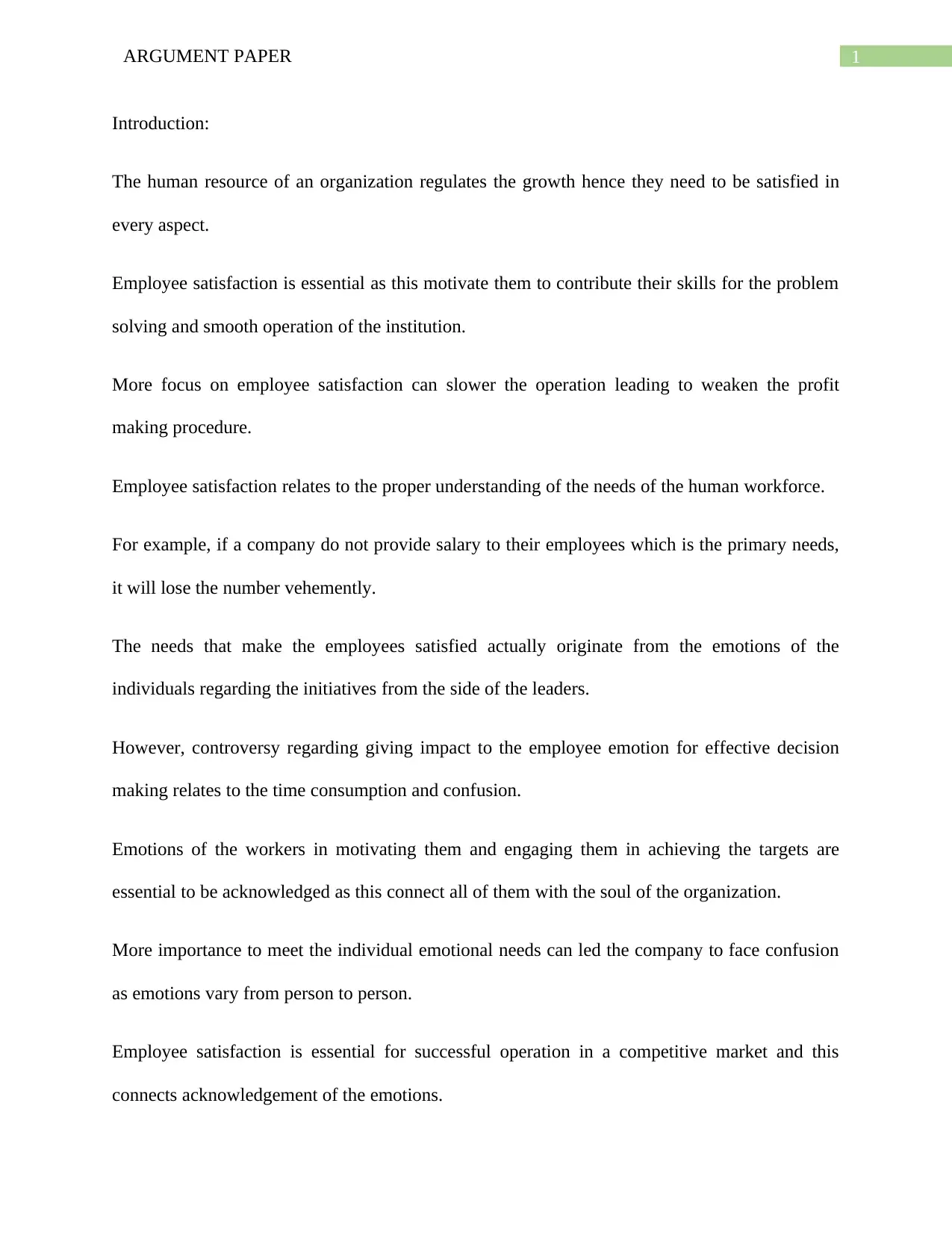
1ARGUMENT PAPER
Introduction:
The human resource of an organization regulates the growth hence they need to be satisfied in
every aspect.
Employee satisfaction is essential as this motivate them to contribute their skills for the problem
solving and smooth operation of the institution.
More focus on employee satisfaction can slower the operation leading to weaken the profit
making procedure.
Employee satisfaction relates to the proper understanding of the needs of the human workforce.
For example, if a company do not provide salary to their employees which is the primary needs,
it will lose the number vehemently.
The needs that make the employees satisfied actually originate from the emotions of the
individuals regarding the initiatives from the side of the leaders.
However, controversy regarding giving impact to the employee emotion for effective decision
making relates to the time consumption and confusion.
Emotions of the workers in motivating them and engaging them in achieving the targets are
essential to be acknowledged as this connect all of them with the soul of the organization.
More importance to meet the individual emotional needs can led the company to face confusion
as emotions vary from person to person.
Employee satisfaction is essential for successful operation in a competitive market and this
connects acknowledgement of the emotions.
Introduction:
The human resource of an organization regulates the growth hence they need to be satisfied in
every aspect.
Employee satisfaction is essential as this motivate them to contribute their skills for the problem
solving and smooth operation of the institution.
More focus on employee satisfaction can slower the operation leading to weaken the profit
making procedure.
Employee satisfaction relates to the proper understanding of the needs of the human workforce.
For example, if a company do not provide salary to their employees which is the primary needs,
it will lose the number vehemently.
The needs that make the employees satisfied actually originate from the emotions of the
individuals regarding the initiatives from the side of the leaders.
However, controversy regarding giving impact to the employee emotion for effective decision
making relates to the time consumption and confusion.
Emotions of the workers in motivating them and engaging them in achieving the targets are
essential to be acknowledged as this connect all of them with the soul of the organization.
More importance to meet the individual emotional needs can led the company to face confusion
as emotions vary from person to person.
Employee satisfaction is essential for successful operation in a competitive market and this
connects acknowledgement of the emotions.
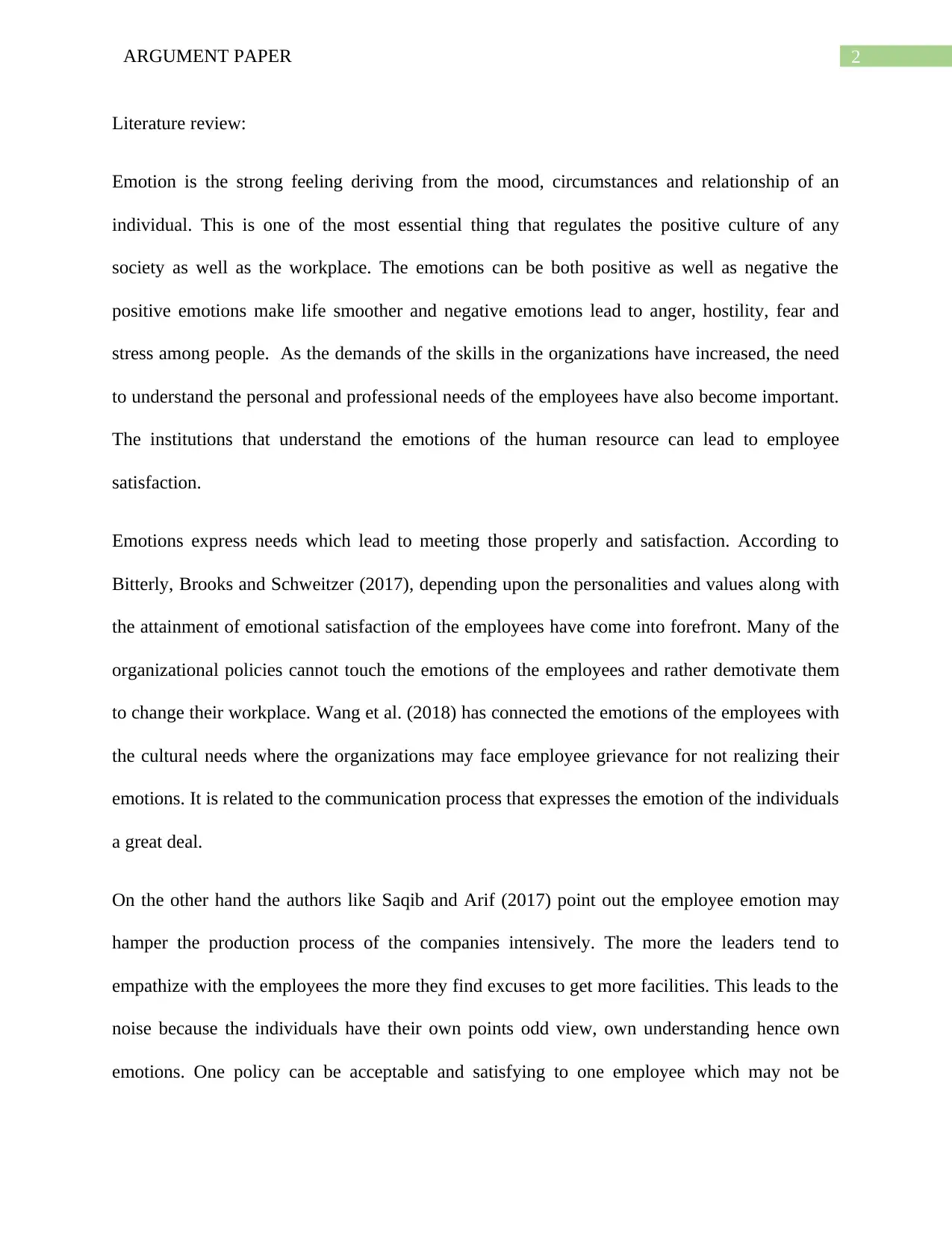
2ARGUMENT PAPER
Literature review:
Emotion is the strong feeling deriving from the mood, circumstances and relationship of an
individual. This is one of the most essential thing that regulates the positive culture of any
society as well as the workplace. The emotions can be both positive as well as negative the
positive emotions make life smoother and negative emotions lead to anger, hostility, fear and
stress among people. As the demands of the skills in the organizations have increased, the need
to understand the personal and professional needs of the employees have also become important.
The institutions that understand the emotions of the human resource can lead to employee
satisfaction.
Emotions express needs which lead to meeting those properly and satisfaction. According to
Bitterly, Brooks and Schweitzer (2017), depending upon the personalities and values along with
the attainment of emotional satisfaction of the employees have come into forefront. Many of the
organizational policies cannot touch the emotions of the employees and rather demotivate them
to change their workplace. Wang et al. (2018) has connected the emotions of the employees with
the cultural needs where the organizations may face employee grievance for not realizing their
emotions. It is related to the communication process that expresses the emotion of the individuals
a great deal.
On the other hand the authors like Saqib and Arif (2017) point out the employee emotion may
hamper the production process of the companies intensively. The more the leaders tend to
empathize with the employees the more they find excuses to get more facilities. This leads to the
noise because the individuals have their own points odd view, own understanding hence own
emotions. One policy can be acceptable and satisfying to one employee which may not be
Literature review:
Emotion is the strong feeling deriving from the mood, circumstances and relationship of an
individual. This is one of the most essential thing that regulates the positive culture of any
society as well as the workplace. The emotions can be both positive as well as negative the
positive emotions make life smoother and negative emotions lead to anger, hostility, fear and
stress among people. As the demands of the skills in the organizations have increased, the need
to understand the personal and professional needs of the employees have also become important.
The institutions that understand the emotions of the human resource can lead to employee
satisfaction.
Emotions express needs which lead to meeting those properly and satisfaction. According to
Bitterly, Brooks and Schweitzer (2017), depending upon the personalities and values along with
the attainment of emotional satisfaction of the employees have come into forefront. Many of the
organizational policies cannot touch the emotions of the employees and rather demotivate them
to change their workplace. Wang et al. (2018) has connected the emotions of the employees with
the cultural needs where the organizations may face employee grievance for not realizing their
emotions. It is related to the communication process that expresses the emotion of the individuals
a great deal.
On the other hand the authors like Saqib and Arif (2017) point out the employee emotion may
hamper the production process of the companies intensively. The more the leaders tend to
empathize with the employees the more they find excuses to get more facilities. This leads to the
noise because the individuals have their own points odd view, own understanding hence own
emotions. One policy can be acceptable and satisfying to one employee which may not be
⊘ This is a preview!⊘
Do you want full access?
Subscribe today to unlock all pages.

Trusted by 1+ million students worldwide
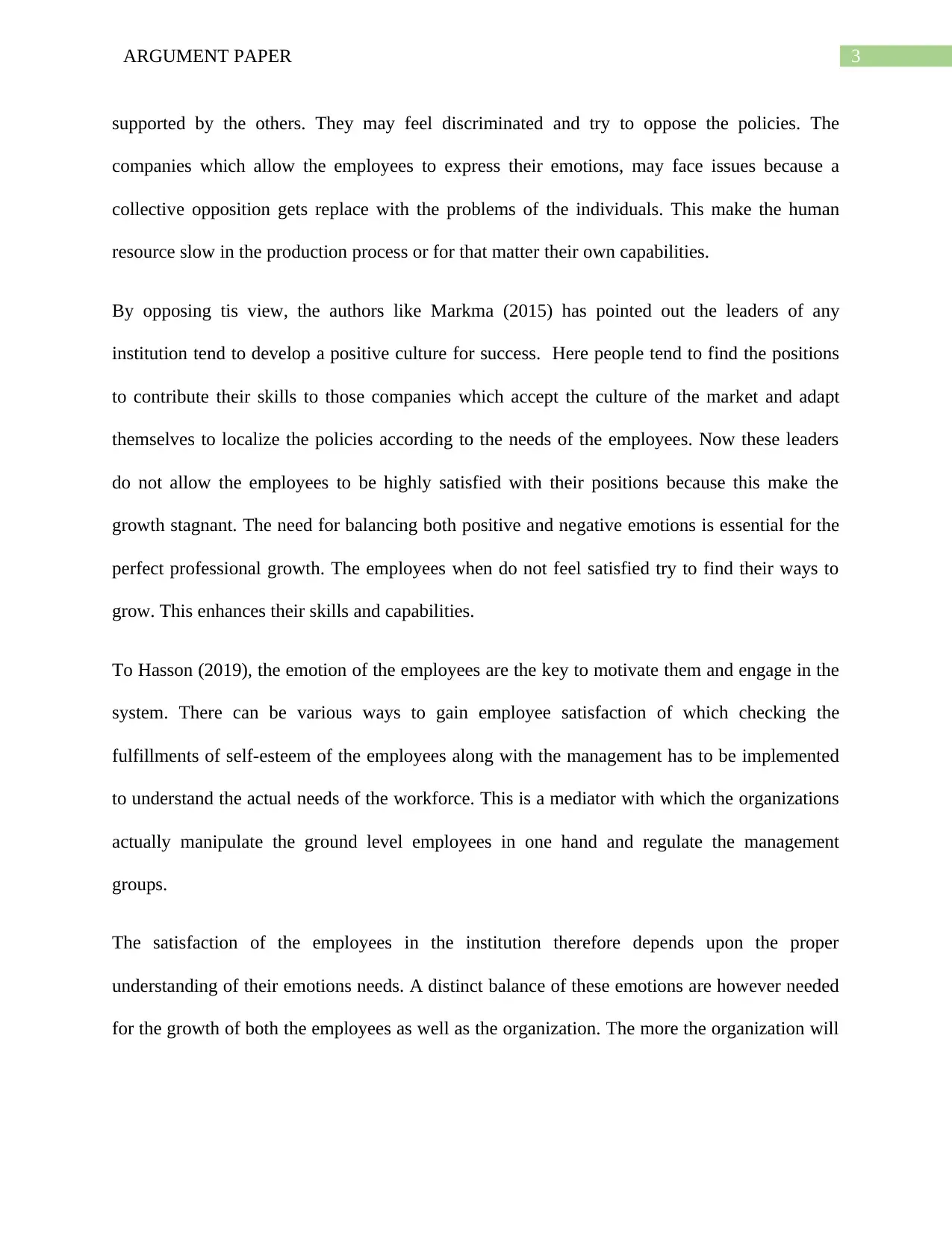
3ARGUMENT PAPER
supported by the others. They may feel discriminated and try to oppose the policies. The
companies which allow the employees to express their emotions, may face issues because a
collective opposition gets replace with the problems of the individuals. This make the human
resource slow in the production process or for that matter their own capabilities.
By opposing tis view, the authors like Markma (2015) has pointed out the leaders of any
institution tend to develop a positive culture for success. Here people tend to find the positions
to contribute their skills to those companies which accept the culture of the market and adapt
themselves to localize the policies according to the needs of the employees. Now these leaders
do not allow the employees to be highly satisfied with their positions because this make the
growth stagnant. The need for balancing both positive and negative emotions is essential for the
perfect professional growth. The employees when do not feel satisfied try to find their ways to
grow. This enhances their skills and capabilities.
To Hasson (2019), the emotion of the employees are the key to motivate them and engage in the
system. There can be various ways to gain employee satisfaction of which checking the
fulfillments of self-esteem of the employees along with the management has to be implemented
to understand the actual needs of the workforce. This is a mediator with which the organizations
actually manipulate the ground level employees in one hand and regulate the management
groups.
The satisfaction of the employees in the institution therefore depends upon the proper
understanding of their emotions needs. A distinct balance of these emotions are however needed
for the growth of both the employees as well as the organization. The more the organization will
supported by the others. They may feel discriminated and try to oppose the policies. The
companies which allow the employees to express their emotions, may face issues because a
collective opposition gets replace with the problems of the individuals. This make the human
resource slow in the production process or for that matter their own capabilities.
By opposing tis view, the authors like Markma (2015) has pointed out the leaders of any
institution tend to develop a positive culture for success. Here people tend to find the positions
to contribute their skills to those companies which accept the culture of the market and adapt
themselves to localize the policies according to the needs of the employees. Now these leaders
do not allow the employees to be highly satisfied with their positions because this make the
growth stagnant. The need for balancing both positive and negative emotions is essential for the
perfect professional growth. The employees when do not feel satisfied try to find their ways to
grow. This enhances their skills and capabilities.
To Hasson (2019), the emotion of the employees are the key to motivate them and engage in the
system. There can be various ways to gain employee satisfaction of which checking the
fulfillments of self-esteem of the employees along with the management has to be implemented
to understand the actual needs of the workforce. This is a mediator with which the organizations
actually manipulate the ground level employees in one hand and regulate the management
groups.
The satisfaction of the employees in the institution therefore depends upon the proper
understanding of their emotions needs. A distinct balance of these emotions are however needed
for the growth of both the employees as well as the organization. The more the organization will
Paraphrase This Document
Need a fresh take? Get an instant paraphrase of this document with our AI Paraphraser

4ARGUMENT PAPER
value them, the more motivated the human resource will be and act for the success of the
company.
value them, the more motivated the human resource will be and act for the success of the
company.
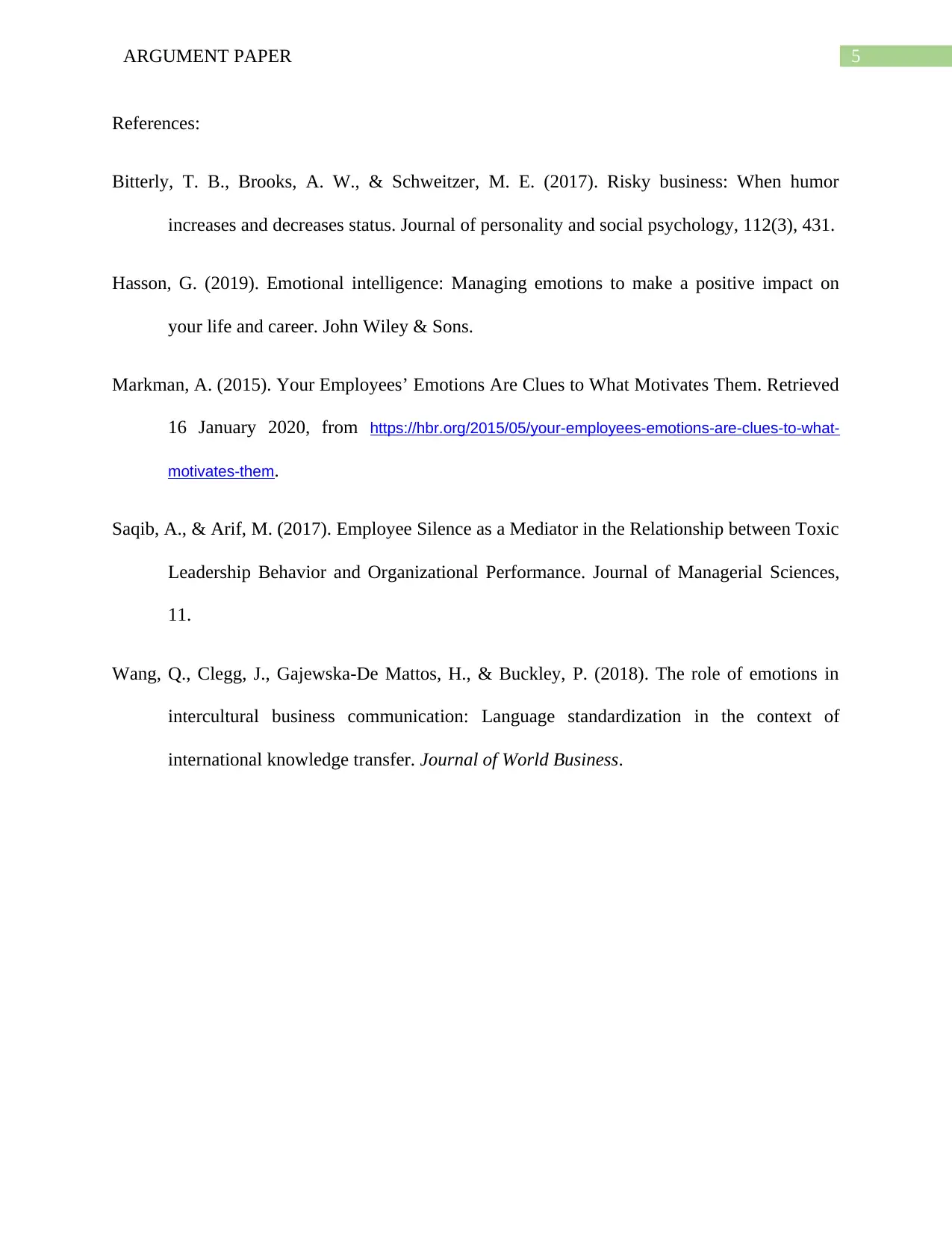
5ARGUMENT PAPER
References:
Bitterly, T. B., Brooks, A. W., & Schweitzer, M. E. (2017). Risky business: When humor
increases and decreases status. Journal of personality and social psychology, 112(3), 431.
Hasson, G. (2019). Emotional intelligence: Managing emotions to make a positive impact on
your life and career. John Wiley & Sons.
Markman, A. (2015). Your Employees’ Emotions Are Clues to What Motivates Them. Retrieved
16 January 2020, from https://hbr.org/2015/05/your-employees-emotions-are-clues-to-what-
motivates-them.
Saqib, A., & Arif, M. (2017). Employee Silence as a Mediator in the Relationship between Toxic
Leadership Behavior and Organizational Performance. Journal of Managerial Sciences,
11.
Wang, Q., Clegg, J., Gajewska-De Mattos, H., & Buckley, P. (2018). The role of emotions in
intercultural business communication: Language standardization in the context of
international knowledge transfer. Journal of World Business.
References:
Bitterly, T. B., Brooks, A. W., & Schweitzer, M. E. (2017). Risky business: When humor
increases and decreases status. Journal of personality and social psychology, 112(3), 431.
Hasson, G. (2019). Emotional intelligence: Managing emotions to make a positive impact on
your life and career. John Wiley & Sons.
Markman, A. (2015). Your Employees’ Emotions Are Clues to What Motivates Them. Retrieved
16 January 2020, from https://hbr.org/2015/05/your-employees-emotions-are-clues-to-what-
motivates-them.
Saqib, A., & Arif, M. (2017). Employee Silence as a Mediator in the Relationship between Toxic
Leadership Behavior and Organizational Performance. Journal of Managerial Sciences,
11.
Wang, Q., Clegg, J., Gajewska-De Mattos, H., & Buckley, P. (2018). The role of emotions in
intercultural business communication: Language standardization in the context of
international knowledge transfer. Journal of World Business.
⊘ This is a preview!⊘
Do you want full access?
Subscribe today to unlock all pages.

Trusted by 1+ million students worldwide
1 out of 6
Related Documents
Your All-in-One AI-Powered Toolkit for Academic Success.
+13062052269
info@desklib.com
Available 24*7 on WhatsApp / Email
![[object Object]](/_next/static/media/star-bottom.7253800d.svg)
Unlock your academic potential
Copyright © 2020–2025 A2Z Services. All Rights Reserved. Developed and managed by ZUCOL.




